6+ SAMPLE Interior Design Project Proposal
-
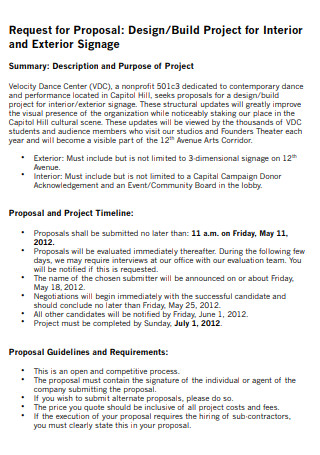
Building Interior Design Project Proposal
download now -
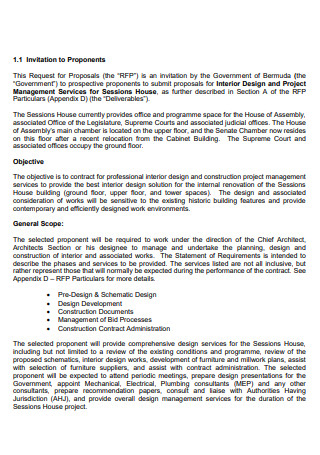
Interior Design Project Management Proposal
download now -

Interior Design Project Fee Proposal
download now -
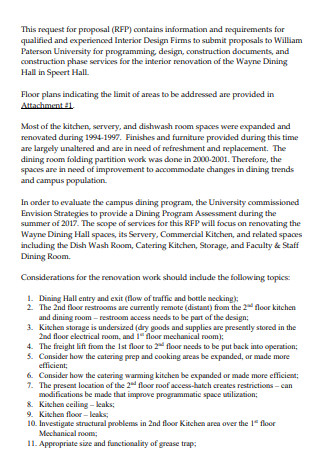
Interior Design Project Services Proposal
download now -

Architectural Interior Design Project Proposal
download now -
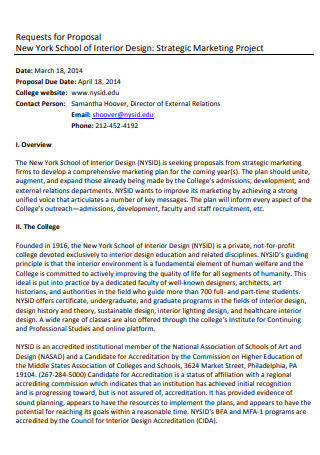
Interior Design Marketing Project Proposal
download now -
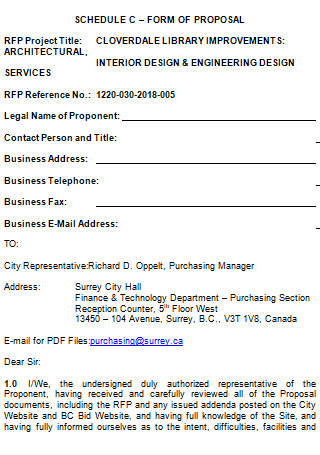
Engineering Interior Design Project Proposal
download now
FREE Interior Design Project Proposal s to Download
6+ SAMPLE Interior Design Project Proposal
What Is an Interior Design Project Proposal?
Importance of Interior Design
How to Write an Interior Design Project Proposal
Additional Steps in Creating an Interior Design Contract
FAQs
What is a must-have for an interior design project proposal?
What is a fee proposal?
What are the important things in interior design?
What Is an Interior Design Project Proposal?
An interior design Project Proposal is a document that is provided to a potential client that needs interior design services. This proposal template has an essential element that will undoubtedly attract clients. Continue reading through the article to know more about the scope of services that an interior designer has and which services are appropriate for which skill set. Other parts of the article will also teach you in writing your own proposal so you can gather and persuade clients to choose you. There are interior design proposal examples and similar proposal templates that you can make use of to base off your proposal and tweak it to your suitability as much as you like.
Importance of Interior Design
Interior design is more than just a matter of appearance; it also has the power to transform even a studio Apartment into a spacious home with the use of correct design and relaxing lighting. A bad interior design, on the other hand, results in a larger house with an insufficient room. Interior designers are specialists at maximizing the various elements involved in interior design. The ability to design a home is not something that everyone possesses. As a result, hiring an interior designer is a good idea since they are equipped to improve the usability and quality of interior space via education, skill, practice, and inspection. There are valid reasons to employ an interior designer, not just when creating a new home but also when renovating an existing one, as it guarantees that the style and design clients’ desire is achieved.
How to Write an Interior Design Project Proposal
If you are an interior designer or a business that provides interior design services, the free sample proposal template will help you sell your services. Company profile, design services, design team, work showcase, project overview, and price are all included in the proposal’s contents. If you also need to prepare for an Interior Design Contract, then there are additional tips below, continue reading the article to reach it. Explore the available proposal for interior design projects which you can freely customize to your liking and can suit your preferences. And with that, the following information will guide you through the steps in writing your own interior design project proposal.
Step 1: Prepare a Cover Letter
Your proposal’s cover letter is frequently the first opportunity to link your idea to the reader’s specific purpose. It appears at the start of a proposal, however, it is not the same as an Executive Summary, which summarizes the main points of your proposal. Your cover letter should include a request for the amount and an introduction to your project in the first sentence, describe how your project and company will further the company’s mission, reference your most recent contact with the company, list the proposal’s contents, provide contact information in case the funder needs additional information, and be signed by your organization’s executive head.
Step 2: Company and Team Information
Independent interior designers and those associated with a company both would need to present themselves in a formal and professional manner to the client. Through an interior design project proposal letter, this step will allow you to present your credentials along with former works and projects you have handled. Clients will appreciate the show of your skills in order to assess whether or not you are fit for the task they envision. Similarly, as a Company, you should be able to present a team that is fit to carry on the role they are assigned with. This will help clients know the names and skills of the team members you are working with to carry on their interior design.
Step 3: Services Offered and Scope of Work
Project scope develops when you begin to undertake work outside of what you and your client agreed on. Designers are seldom excellent at this, which is problematic since it means you will be working billable hours for no pay. This part of the proposal is crucial since what you do is just as essential as when and for how long you will do it. Writing out a timetable with defined milestones is an excellent idea. Examine your past projects for inspiration, and attempt to fill in the blanks for each of the duties involved, such as the amount of time necessary, the number of people engaged, the resources required, and why this is essential. You won’t be forced into repairing it as a favor if your Scope of Work, timeframe, and expectations are clear. You may then explain that the materials and labor are costly and that it will have a negative impact on your end.
Step 4: Estimated Pricing
Set the fees and terms that are most beneficial to you and your associated company. This is the portion that takes a little finesse as you try to strike a balance between your own and your client’s interests. Don’t jack up the price, but don’t be afraid to ask for what you are worth. The scope and timetable sections of your proposal will come in handy here. Simply remove the information from your list and replace them with the pricing. So, how do you come up with these figures? Well, it is debatable. Actually, it is dependent on a number of things. You should consider whether you should charge per hour or if a fixed fee would be more appropriate. In fact, you’ll quickly discover that different sections of the project will necessitate different prices.
Step 5: Terms and Agreement
It is, in essence, a contract between you and your clients. Your consumers have access to the services that you provide. Customers agree to obey the regulations you set out in your terms and conditions in exchange for utilizing these services. Consider terms and conditions agreed to be a one-stop shop for all the important information that clients require before using your services or purchasing something. You may withdraw and cancel services, disable user accounts, manage consumer expectations, and define restrictions for user conduct using a terms and conditions agreement. The terms and conditions are legally binding. Although you have no control over whether your client will thoroughly read this section, in its entirety, you may depend on it in the event of a legal issue. Fairness dictates that neither party be subjected to unreasonable or unjust demands. The purpose of the proposal must be apparent. Before a proposal and contract may be enforced, it must first be agreed to by all parties concerned.
Step 6: Signatures
Except for the sale of land and real estate, very few transactions now require tangible, handwritten signatures. If you don’t sign a credit card purchase slip, for example, it doesn’t imply you haven’t accepted to pay since you have already done so by giving over your card. So signing your name to purchase groceries, houseplants, or any of the few items remaining in life that you don’t buy online, where you never have to submit a signature anyway, is consuming your time. But given that signing your name takes only a few seconds, the time lost isn’t a major problem. Especially within a proposal, you and the other party, which is the client in this situation, would be necessary to bind your acknowledgment and agreement through an exchange of signatures.
Additional Steps in Creating an Interior Design Contract
It is critical to prepare oneself for the unknown before beginning your everyday tasks in interior design. No one lives in a perfect society, and it might be daunting to entrust your knowledge and abilities to strangers in return for a few dollars. All you need to know about interior design project proposals and contracts in this post are already laid out for you within this article. You don’t have to be an expert in the industry of an interior designer to be aware of the necessities there are to preparing a contract and other legal paperwork. So, what does a formal interior design contract entail?
The Interior Designer Contract is a legal document that binds you and your clients together. As a result, you will need to provide a clear scope of work, pricing, payment conditions, mark-ups, and insurance policy. You will be protected against misunderstandings and turmoil with a proper interior design contract. All should be okay as long as both parties have signed the legal contract. It’s a good idea to have your lawyer look through the document simply to make sure everything is in order.
FAQs
What is a must-have for an interior design project proposal?
It’s all about how you draw in people with a beautiful design. Your mood board will catch their attention, and a narrative will keep their attention. Are you designing a blank yard-turned-high end park? Take them through the intricacies and show them how each piece pulls the natural world into their suburban house. Explain how the new open floor design not only provides them more room but also enables family members to interact regardless of where they are in the house.
What is a fee proposal?
A Fee Proposal is a document prepared by a consultant for a potential client that details the services the consultant intends to provide and the price that will be charged. This may be in the form of a letter, or it could be a longer document with a cover letter. Be sure to consider the project context when coming up with a proposal for the fee since you cannot base the budget off of any case but the data tied to the interior design project. Calculate the necessary fee and present it along with the proposal to inform the client of the fee they will have come up with. The client may suggest an alternate arrangement once they receive the fee proposal, and it is your task to settle and come to an agreement especially concerning money in purchasing items inside the house as well as your own talent fee.
What are the important things in interior design?
These interior design components, which include space that is about a certain type of house, especially the balance of negative and positive space, must be considered in an Interior Design Proposal. Horizontal, vertical, and dynamic lines are examples of lines. Geometric (angular) or natural forms or shapes are both possible (curved). Different forms of light connote different emotions, therefore light may set the ambiance of any room. When it comes to color, it’s vital to remember that various hues evoke distinct emotions. Actual and visible textures are the two types of texture. Finally, the design draws attention to a certain area of your homes, such as the ceiling, staircase, or walls. The key to producing an aesthetically attractive interior is to keep all of the components of the design balanced.
Clients want to make sure they chose the best company or individual to creatively decorate and fill their homes with aesthetically pleasing items and furniture. No one wants to go for irresponsible and skill-lacking professionals. At the same time, competitors will race to convince clients that they are the best choice for the job. This is why in order to appear different and persuade further the client that you are the person for the task, you should prepare this interior design project proposal so that they will see how valuable you are and what you may offer to the table. Make sure to review the contents of this article as you go about writing your project proposal for interior design. The available interior design project proposal sample will guide you through it.
